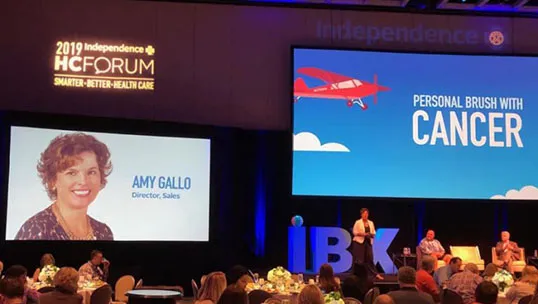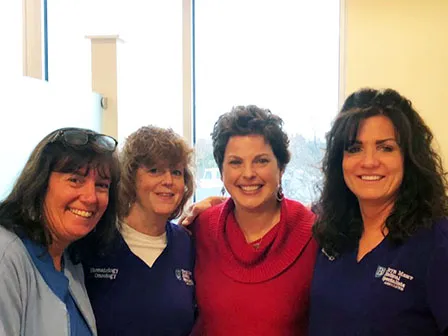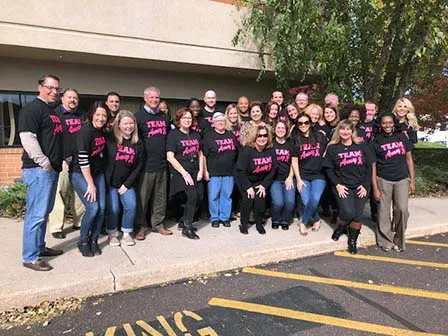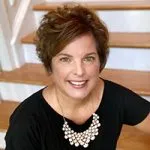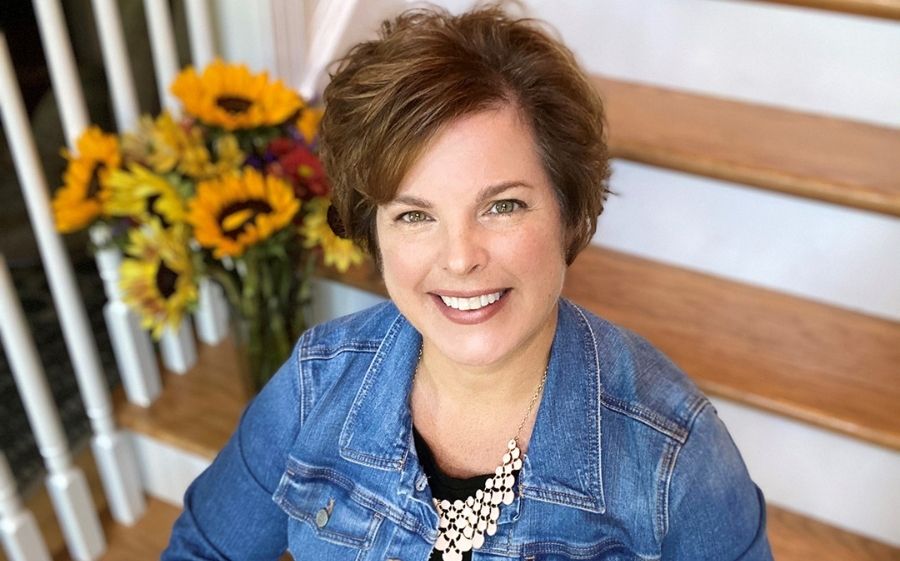
Published: 10/18/2023 - 8:00 AM
As I reflect on the past three years of my life, if I were to sum things up in one word, it would be: grateful. Incredibly grateful. My journey has been emotional, raw, powerful, scary. And, within all of that, there were some real moments of strength.
On October 3, 2017, I was diagnosed with breast cancer. It was found through a routine mammogram. I can honestly say that early detection saved my life. This is my story.
The Diagnosis
In 2016, the year before I was diagnosed with breast cancer, I went for my annual mammogram. As I was leaving my appointment, the front desk had me schedule my next annual exam. When the end of September 2017 rolled around, I saw “mammogram” on my calendar, which I had completely forgotten about since I scheduled the appointment a year ago. I went to my appointment and got on with my busy week.
When I was asked to return for an ultrasound, I wasn’t terribly worried. But when the results of the ultrasound came back, they told me they found something small and wanted to do a biopsy. When you hear “biopsy,” it freaks you out. So, of course, I started Googling. I read that 80 percent of biopsies come back negative. I held on to that statistic and felt that the odds were on my side. I was sure they would find that everything was fine.
I remember precisely where I was and what I was doing when the doctor called with the results of the biopsy. I had just returned from walking our puppy and was standing in my front yard where I could see my children through the window doing their homework. The phone rang and time literally stood still. I don’t remember the exact words, but my doctor said in the kindest way he could, “You have breast cancer.” I next called my husband, told him the news and then had to get myself together and return into the house like nothing was wrong.
I can honestly say it was an out-of-body experience, and all I could think was that this was NOT how things were supposed to be. My doctor immediately said to me, “Do not Google anything. You may only look at the Mayo Clinic website and breastcancer.org for more information. Don’t look anywhere else.” I learned that evening that I had many decisions to make in a short amount of time.
Cancer College
I learned that there are different types of breast cancer, and each type of cancer is fueled by something different. Some cancers are driven by hormones, and my form, known as HER2-positive, was aggressive and was fueled by a protein that tells cancer cells to replicate.
Within two weeks of my diagnosis I was facing a whirlwind of doctors’ appointments, a breast MRI, and genetic testing. I spent the morning of my 46th birthday meeting with the genetic counselor and spent the afternoon meeting with a reconstructive surgeon. When you are diagnosed with cancer, you immediately have to learn a different language. You are dropped into “cancer college” and you are a freshman. You don’t know where you are going. You don’t know the rules or the language, and you don’t have any friends in this new school. Now, years later, I feel like a graduate student.
Family History and Genetic Testing
I did have a family history of breast cancer, but my genetic testing showed I was negative for the BRCA gene. Despite the fact that both of my grandmothers had breast cancer later in life, my cancer wasn’t due to genetics. Mine was different. At the time, I didn’t understand the significance of the diagnosis for someone my age; I didn’t understand the aggressiveness of HER2.
Choosing a Treatment Plan
I first had to decide between a lumpectomy with radiation or a bilateral (double) mastectomy. I weighed the pros and cons of my choices and ultimately decided on the double mastectomy with reconstruction. I decided to meet my aggressive cancer with the most aggressive option available to me. From the day I was diagnosed, my doctor told me that I had six weeks to not only decide on my procedure, but to actually have it done. On Halloween, (approximately four weeks after my initial diagnosis), I underwent a double mastectomy with reconstruction in a nine-hour surgery. Following the surgery, I received good news: my lymph nodes were clear, confirming that the cancer had not spread.
In mid-November, I met with an oncologist who told me that he recommended chemotherapy. I honestly was surprised and scared. I thought clear lymph nodes meant I didn’t need chemotherapy. The surgery didn’t scare me, but chemo scared the hell out of me. My doctor explained that because of my HER2 status, statistically, without chemo, my chance of recurrence was 15 percent. With chemo, I could reduce that chance to 2 percent. I couldn’t argue with those odds. On December 7, I started chemotherapy.
Chemotherapy
I’ve had 26 rounds of chemotherapy, four surgeries, four echocardiograms, and a whole lot of time in doctors’ offices, but most importantly, a different perspective on things.
At first, the thought of going to four-hour chemotherapy infusions once a week seemed horrible. I still hadn’t reconciled that this was happening to me. At my first treatment, I met the most wonderful group of nurses who made a very stressful and sad experience welcoming. They are amazing and truly special people and hold a special place in my heart!
Giving Back
As crazy as it sounds, getting diagnosed with breast cancer was a gift. You get a new lease on life, a new perspective and your priorities change. I’ve been humbled by the generosity and kindness shown to me by friends, family, coworkers, colleagues, and strangers. During my diagnosis and treatment, I kept thinking, “I need to do something to give back. How can I take my experience and make a difference?”
Unite For HER
I was first introduced to Unite For HER by one of my colleagues. We attended a Wellness Day together, and I am forever grateful to her for introducing me to this great organization. I was so impressed by Unite For HER and its mission that I met with their founder and CEO to discuss how I could “pay it forward.” I began serving on the Unite For HER board while I was still in treatment, and this year my role expanded as I became the vice chair of the board.
Unite For HER helped me take back control — it gave me hope and light in a dark time. Its mission is to enrich the health and well-being of those diagnosed with breast and ovarian cancers — for life — by funding and delivering integrative therapies, services, resources, and products. It is the only program of its kind and has served over 6,000 individuals with breast or ovarian cancer. It has also funded and provided more than 55,000 integrative therapies.
This year, Unite for HER shifted to serve in a virtual environment which allows the organization to affect the lives of women (and men) across the country. We all know someone who has been touched by breast or ovarian cancer, and Unite for HER is a tangible and meaningful way to provide support at a time when it is most needed.
I am honored to be able to use both my professional and my very personal experience to give back and help others.
My Biggest Piece of Advice
My diagnosis changed me in ways I could never have imagined. My perspective and priorities are different.
One of the biggest lessons I learned is the importance of self-care. Don’t put off those routine doctor’s appointments. Don’t wait for a convenient time. Don’t let life get in the way. I wrote a thank-you note to the office manager where I had that routine mammogram, the person who did the screening, and the most important person, the person at the desk who insisted I schedule my next screening — the one who saved my life. I am so grateful that I can say I am a breast cancer survivor because of them.
Early Detection Saved My Life
If I didn’t make my appointment when I did, things would have turned out differently for me. If I decided to put off my mammogram until January instead of having it in September, my cancer would have advanced past stage 1. We always think that we have more time and that we can wait until it is more convenient, but the difference of just a few months changed everything for me. If you take away only one thing from reading this, it’s to take advantage of preventive care services. Beginning at age 40, women are covered for preventive mammography annually.1 Put yourself first, make that appointment. Use these services. It saved my life.
Three years ago, I was blissfully unaware, but now I don’t know that I’d trade this journey. I think I’m better for it. You don’t know how strong you are until you don’t have a choice. I chose to stay positive, to find the good in a difficult situation, and to give back. As a cancer survivor, I’m part of a special “club” with an even more special bond — the women I’ve met amaze and inspire me every day.
1 Commercial members only. Your specific needs for preventive services may vary according to your personal risk factors. Your health care provider is always your best resource for determining if you’re at increased risk for a condition. Some services may require precertification/preapproval.
About the Author
Amy Gallo
Amy is director of sales at Independence Blue Cross where she leads mid-market account management teams responsible for customer and broker relations, customer retention, and growth. Amy holds a BS degree from Villanova University and an MBA from St. Joseph’s University. Amy is a breast cancer survivor and an advocate for those affected by this disease. Amy and her husband Frank live in Glen Mills with their twins, Abby and Matthew.
Original post by Amy Gallo from Independence Blue Cross.
